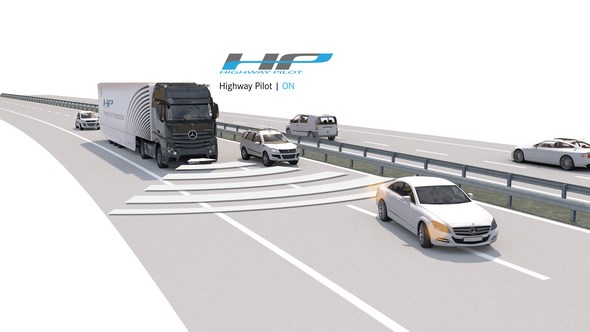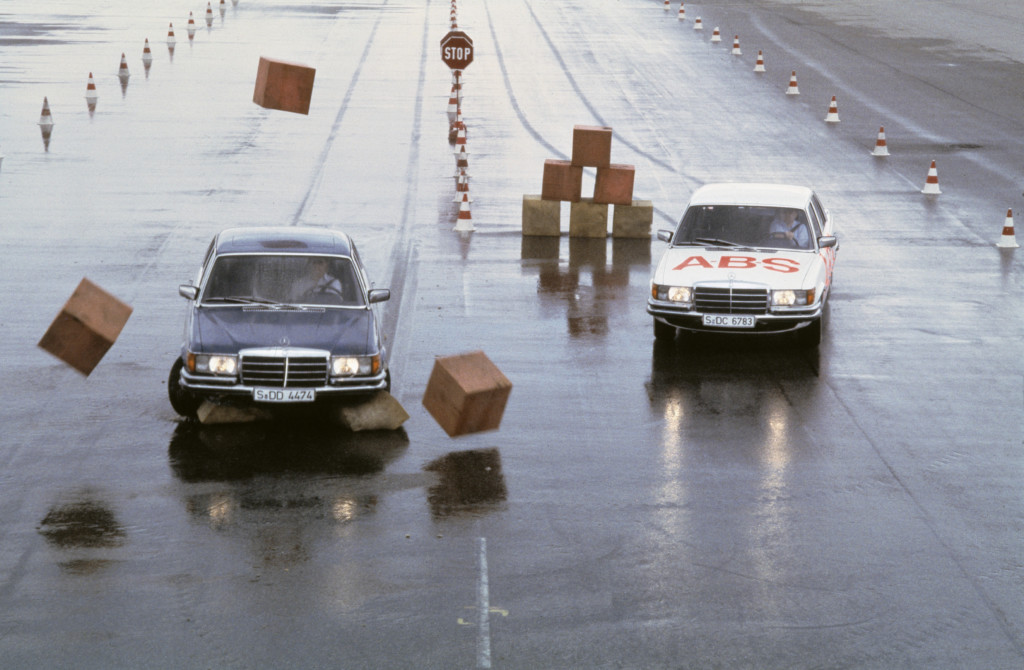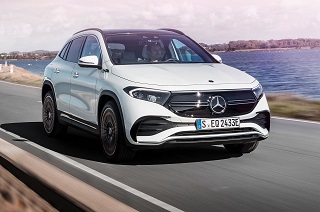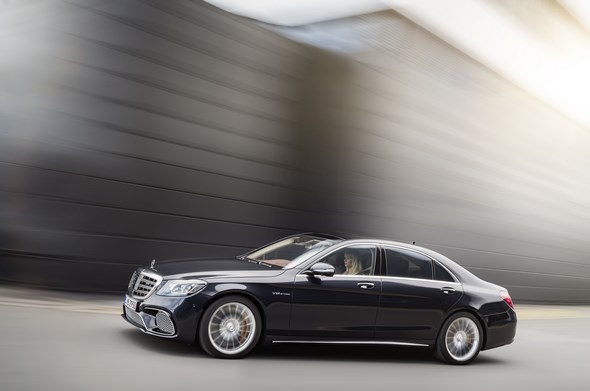Mercedes-Benz Actros with Highway Pilot – world premiere on public roads

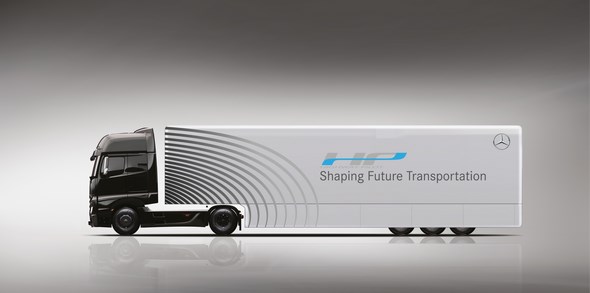
- Mercedes-Benz Actros with Highway Pilot is the first series-production truck to drive on a partially automated basis on the motorway
- Highway Pilot: more alert and attentive than any driver
- Shaping Future Transportation: Daimler Trucks focuses its attention on transport of the future
- Automated driving functions promote safety and efficiency in road traffic
Stuttgart – On the A8 between Denkendorf and Stuttgart airport Daimler Trucks is today having the world’s first series-production truck to operate on an automated basis drive on the motorway.
Together with the state of Baden-Württemberg’s Prime Minister Winfried Kretschmann, Dr Wolfgang Bernhard, Board Member of Daimler AG responsible for Trucks and Buses, is undertaking the maiden journey in the Mercedes-Benz Actros with Highway Pilot system.
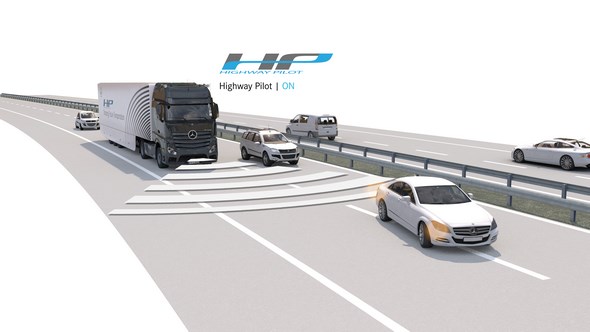
With this permit the truck is allowed to drive on motorways on an automated basis. The truck used for the premiere is a standard Mercedes-Benz Actros equipped with the intelligent Highway Pilot system for this test of autonomous driving on public roads.

The truck is approved as a test vehicle in accordance with §19/6 StVZO (German road traffic type approval law). The Rhineland German Technical Inspection Authority had inspected the vehicle and issued an expert opinion.
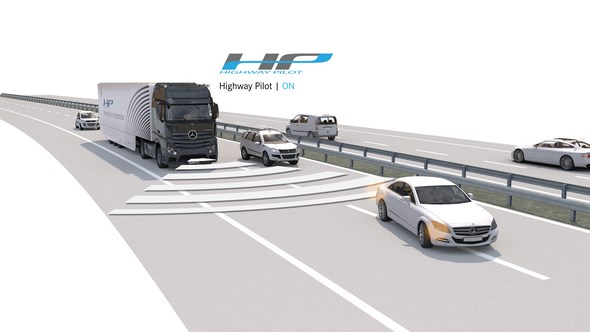
On this basis the Baden-Württemberg regional council granted an exemption in accordance with §70 StVZO.

„Today’s premiere is a further important step towards the market maturity of autonomously driving trucks – and towards the safe, sustainable road freight transport of the future“, said Daimler Board Member Dr Bernhard.
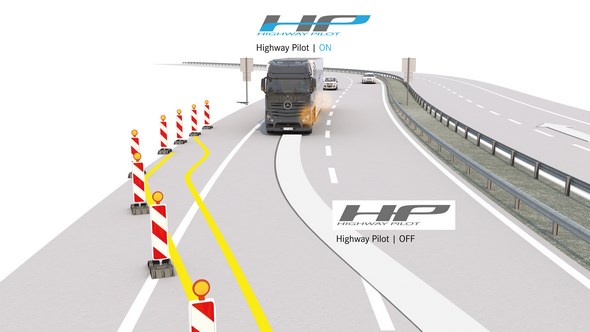
Sven Ennerst, Head of Development Daimler Trucks, commented: „We are delighted that Baden-Württemberg has approved these tests for us.
In so doing the state is demonstrating true pioneering spirit. And we are of course also delighted that the German Technical Inspection Authority has so clearly confirmed the safety of our system.“
The multi-sensor fusion, i.e. the combination of proven new-generation assistance and safety systems and sensors, enables the truck with the Highway Pilot system to continually observe the entire area in front of the vehicle and to take control itself in certain situations.
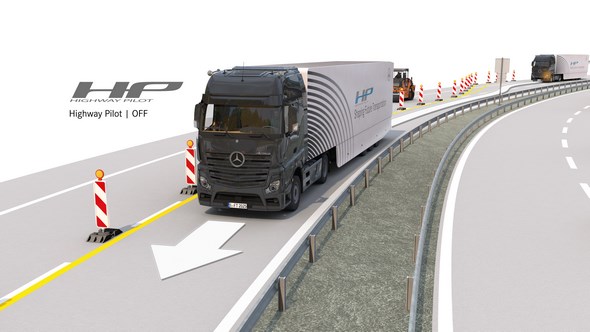
This gives Dr Wolfgang Bernhard the opportunity to take his hands off the wheel without incurring any risks.
Dr Wolfgang Bernhard drives the Mercedes-Benz Actros from the service station onto the motorway towards Karlsruhe.
As soon as the truck has entered the flowing traffic in the right-hand lane, it’s “Highway Pilot On” and the system now offers to take over vehicle operation.
The driver can confirm at the press of a button. The Actros meticulously keeps to its lane and maintains the optimum distance to the vehicle in front of it.
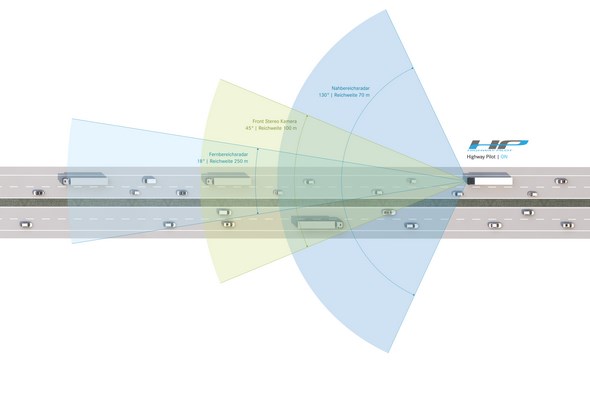
Should the distance become too small or if a vehicle cuts in front of it, the truck brakes. Both vehicle occupants are sitting comfortably in the functional and modern cab and are chatting in a relaxed fashion.
At the airport/trade fair exit the system again asks Wolfgang Bernhard to take control and the truck reverts from automated driving mode to manual control – „Highway Pilot Off“.
He steers the Actros off the motorway and then drives directly back onto the A8 again, this time in the opposite direction. The scenario is exactly the same: the Actros steers and brakes independently in the flowing motorway traffic.
If it approaches an obstacle, such as roadworks here on the A8, the system asks the driver to take over the vehicle. If the roadworks are behind the truck, the Highway Pilot can once again take over control of the vehicle.
The system safely assists both occupants up to the Wendlingen exit. Here Wolfgang Bernhard again takes over the driving and steers the truck off the motorway.
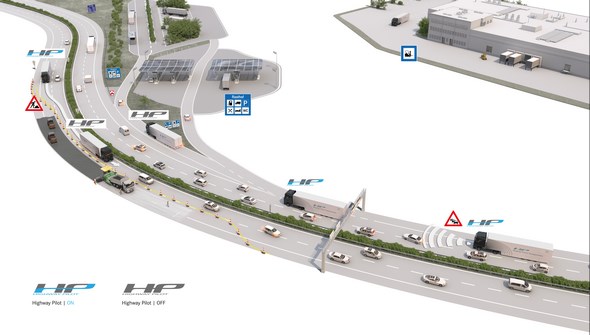
The machine is a safer driver than any human being
The Mercedes-Benz Actros is fitted with the 12.8 l engine, OM 471 and all the proven assistance and safety systems, such as Mercedes PowerShift 3, Predictive Powertrain Control (PPC), Active Brake Assist 3, proximity control, drowsiness detection and a Fleetboard vehicle computer.
These systems are linked with the sensors of the Highway Pilot – radar and stereo camera. So all the technology of the Actros with Highway Pilot is in the vehicle, and the truck does not need the internet for its automated driving function.
The system is ideal for the motorway: it maintains the correct distance to the vehicle in front and brakes in good time if another vehicle cuts out onto the road in front of it.
The Highway Pilot does not replace the driver, but supports and relieves the strain on them by dealing with monotonous stretches for them and taking care of annoying stop-and-go driving in a traffic jam.
In automated mode the driver has control over the truck at all times and in tricky situations can take over driving of the vehicle again. The redundancy in the sensor system and fail-safer components such as the steering and brakes ensure an extremely high safety standard.
If the minimum prerequisites for the system are not present due to bad weather or missing road markings, the Highway Pilot issues acoustic and visual impulses to ask the driver to take over.
The driver has sufficient time to take over the task of driving. If there is no reaction from the driver, the truck brings itself to a standstill independently and safely.
Around two thirds of all accidents in road traffic are rear-end collisions and accidents resulting from unintentionally leaving the lane. Often the causes are drowsiness, distraction and driving errors.
This is where the Highway Pilot is superior to any human being. It is alert, concentrated and relaxed. Without exception, round the clock, seven days a week.
Today Daimler Trucks is already developing solutions for the transport of tomorrow
The growing transport volume has an enormous influence on changes in the world of traffic. As a pioneer in the automotive industry Daimler is taking responsibility and is constantly working on ways of meeting the complex challenges of traffic density, bottlenecks and cost pressures in the transport sector.
Long-distance transport trucks in particular are predestined for autonomous driving. It enables a considerable increase in the efficiency of the transport sector, especially through the reduction in TCO.
Increasing road safety and cutting fuel consumption are hugely important aspects in particular in long-distance transport.
A long-distance transport truck drives an average of 130,000 km per annum. The autonomously driving truck supports the driver by taking care of monotonous stretches of road and tiring stop-and-go traffic in a tailback for them.
Tests carried out by Daimler Research on the driver’s condition during automated driving have proven that the driver takes longer to become tired as a result of this relief.
Their attention rate is around 25 percent higher than when driving in the conventional Actros if they have the opportunity to attend to other tasks.
Connectivity increasing in importance in the traffic of the future
The use of digital networks in traffic is on the threshold of a major development. Connectivity means not only the combination of all assistance, safety and telematics systems with the new sensor systems; it also encompasses intelligent networking between vehicles themselves and with the transport infrastructure.
If a truck is informed at an early stage about traffic incidents occurring far in front of or behind it, appropriate action can be taken.
This means that in autonomous driving mode the handling adapts to the characteristics of the route ahead. Through the more homogeneous flow of traffic, fuel consumption and emissions fall.
At the same time the transport times will become more calculable and the major assemblies of the trucks concerned will also be subjected to less wear thanks to a consistent driving style.
This also reduces the truck’s downtimes due to maintenance and repairs. Relieving the transport infrastructure and optimising the flow of goods are important prerequisites for our customers, to ensure success when on the roads in the future, too.

Step by step to autonomous driving
In July 2014 Mercedes-Benz had its Future Truck 2025 driven on a test track near Magdeburg and in May this year the world premiere of the Freightliner Inspiration Truck caused a sensation.
Daimler was presenting the first truck with a permit for operation on public roads to drive in a highly automated fashion. Both the Future Truck 2025 and the Inspiration
Truck are concept vehicles which are equipped with further functions. The mirror cam, swivelling seat and integral tablet are elements which are not present in the Actros with Highway Pilot.
The reason for this is that the vehicle is approved according to automation level 2 (partially automated driving). This means that the Highway Pilot can assist the driver in certain situations both for longitudinal and lateral guidance.
However the driver must constantly monitor the vehicle and the road and traffic conditions and at all times be in a position to take control of the truck again.
For this reason, activities such as the use of a tablet during the automated journey are not currently allowed. On the test track in Magdeburg the Future Truck 2015 already demonstrated automation stage 3 (highly automated driving): this means that the system independently detects the system limits and accordingly asks the driver to take over the task of driving.
And at this automation level the driver no longer has to monitor the system on a permanent basis and could also carry on with other activities during the journey.
Daimler Trucks is focusing on constantly developing mobility solutions for the future and readily assumes the leadership role for automated driving in the truck, Dr Bernhard emphasises: „Our claim is ‘Shaping Future Transportation’.
And with today’s premiere we are once again impressively backing up this claim. We are shaping the future of transportation with the first autonomously driving production truck.“
World premiere on the A8: Daimler Trucks testing the first series-production autonomous truck on public roads
- Maiden journey with Baden-Württemberg’s Minister-President Winfried Kretschmann and Daimler Executive Board member Dr Wolfgang Bernhard
- Series-production Mercedes-Benz Actros truck equipped with the intelligent Highway Pilot system
- Minister-President Kretschmann: “A new age of mobility is dawning.”
- Dr Bernhard: “Today’s premiere is a further important step towards the market maturity of autonomously driving trucks – and towards the safe, sustainable road freight transport of the future.”
Stuttgart – Dr Wolfgang Bernhard, the member of the Daimler AG Board of Management responsible for Daimler Trucks and Buses, and Winfried Kretschmann, Minister-President of the state of Baden-Württemberg, made a historic journey today.
As driver and co-driver, they piloted the world’s first series-production autonomous truck along Autobahn 8 between Denkendorf and Stuttgart.
The truck used for the premiere is a standard Mercedes-Benz Actros equipped with the intelligent Highway Pilot system for this test of autonomous driving on public roads.
The truck is registered as a test vehicle according to Sec. 19/6 of the German Road Traffic Licencing Regulations (StVZO). The test organisation TÜV Rhineland previously inspected the vehicle and issued an expert report.
On this basis the Baden-Württemberg state government granted exceptional permission according to Sec. 70 StVZO.
“For today’s ‘maiden journey’ there could be no place better than this stretch of the motorway. Not only because Baden-Württemberg was the birthplace of the automobile, but also because Daimler is developing and producing cars that set standards worldwide just a stone’s throw from here.
Partially autonomous and autonomous driving indicates that a new age of mobility is dawning. It marks an important step towards more intelligent and above all more efficient use of the available infrastructure.
Autonomously driving and networked vehicles improve the flow of traffic and can play a decisive role in helping to avoid traffic jams and relieving the strain on drivers.
They also boost traffic safety,” observes Minister-President Kretschmann. “In view of this, the state government is currently planning to set up a test field for autonomous and partially autonomous driving which will be open to any potentially effective technologies.
This project enables the technology and infrastructure required in this connection to be tested and examined on motorways, rural and urban roads.
It is also intended to promote the development of the legal framework for autonomous driving.”
“Today’s premiere is a further important step towards the market maturity of autonomously driving trucks – and towards the safe, sustainable road freight transport of the future.
During the world premiere of our Freightliner Inspiration truck in the USA in May, we announced that the Highway Pilot would soon also be tested on German roads – and just five months later we have achieved this interim goal.
I am most grateful to the state government of Baden-Württemberg, which has given us so much active support in this undertaking.
Safe testing in real traffic is absolutely decisive for the development of this technology to market maturity. We are now able to proceed with this,” says Daimler Executive Board member Dr. Bernhard.
Highway Pilot allows semi-autonomous driving –
driver retains full control
The version of the Highway Pilot installed in today’s world-premiere Actros allows semi-autonomous driving. This means that while the Highway Pilot is able to steer the truck by itself on motorways, the driver retains full responsibility, needs to monitor the traffic at all times and must be able to intervene at any time.
The Highway Pilot can therefore be compared to the autopilot commonly used in aviation.
The system includes front-mounted radar and a stereo camera, as well as well-proven assistance systems such as Adaptive Cruise Control +. The technology was adapted for use on public roads.
Smooth interaction between the components was extensively tested. To this end the Highway Pilot has already absolved around 20,000 kilometres on test routes in Germany and the USA.
Redundancy in the sensor systems makes test operations particularly safe. The Highway Pilot is also able to respond appropriately to unforeseen circumstances.
Should the weather or the road markings deteriorate excessively, the system prompts the driver to take over the steering again. The driver has sufficient time to do this.
Should the driver still fail to react to the audible and visual signals of the Highway Pilot, the truck is automatically brought to a safe stop.
Shaping Future Transportation – Daimler Trucks at the forefront
Daimler Trucks leads the field as a pioneer in autonomous driving. In July 2014 the world’s largest truck manufacturer presented the Mercedes-Benz Future Truck 2025 in Magdeburg.
This concept for the truck of the future demonstrated that Daimler Trucks possesses all the technologies required for autonomous driving.
Only just under one year later, in May this year, the Freightliner Inspiration Truck celebrated its world premiere. In Nevada, USA it received the world’s first road approval for an autonomous truck.
Both the Mercedes-Benz Future Truck 2025 and the Freightliner Inspiration truck are concept vehicles – but with today’s Mercedes-Benz Actros equipped with the Highway Pilot, Daimler Trucks has now sent a series-production autonomous truck onto public roads for the first time.
“We are in a unique position among manufacturers in that we are able to implement leading technologies across all business units and brands. This means that we can drive innovation forward all around the globe,” says Dr Bernhard.
“Our claim is ‘Shaping Future Transportation’. And with today’s premiere we are once again impressively backing up this claim.”
Autonomously driving trucks offer considerable advantages
Autonomous driving has considerable advantages, especially in the road freight transport sector. Firstly, it improves safety: the Highway Pilot system never suffers fatigue or becomes distracted – it is always 100 percent active.
A study by Daimler Trucks has also shown that driver fatigue decreases by 25 percent if they are relieved of monotonous lane-keeping and can focus on other tasks. This will become possible in further development stages of autonomous driving.
Secondly, autonomous trucks improve efficiency: thanks to optimum gearshifting, acceleration and braking, they consume less fuel – which in turn reduces CO2 emissions.
Daimler Trucks expects savings of up to five percent from this. The international consultancy Frost & Sullivan even estimates a reduction of around seven percent.
Thirdly, autonomously driving trucks are more attractive workplaces: the driver’s ability to leave a great deal of the route to the Highway Pilot greatly reduces stress in the cockpit.
Future technology developments will also make it possible for drivers to turn their attention to interesting side activities – e.g. completing documentation on a tablet PC.
These advantages really make themselves felt, as trucks cover very high mileages: in Germany, long-distance trucks cover an average of 130,000 kilometres per year – while passenger cars reach an average of 14,000 kilometres.
Politicians and government bodies must now create the necessary regulatory framework for autonomous driving
Taking the Mercedes-Benz Actros with the Highway Pilot onto the road required special permission from the state government of Baden-Württemberg.
With this permission, the truck is now able to drive semi-autonomously on motorways at speeds of up to 80 km/h nationwide.
“We will be making extensive use of this opportunity to test our Highway Pilot in real traffic conditions,” Dr Bernhard announced.
He reiterated the need for politicians and government bodies to create the necessary regulatory framework, so that in the future autonomous trucks will also be able to drive in Germany without special permission.
To enable the Highway Pilot technology to be brought to market in the next few years, it is first necessary to incorporate the revised Vienna Convention into German law, according to Dr Bernhard.
This is a precondition for the driver being able to leave the steering to the truck’s assistance systems. This is where the Federal Ministry of Transport needs to become active.
Secondly, it is now necessary for the Federal Ministry of Transport and the German Automobile Licensing Authority to initiate the certification process for approval of series-production autonomous trucks.
Thirdly, Brussels needs to adapt Directive ECE R79, which currently only allows autonomous driving at speeds up to 10 km/h.
Dr Bernhard expressly welcomed the federal government’s strategy “Automated and networked driving” presented in mid-September and the test field for autonomous driving which is being planned by the state government of Baden-Württemberg.
The aim must be for Germany, where trucks first took to the roads, also to be where the trucks of the next generation first take to the roads.

